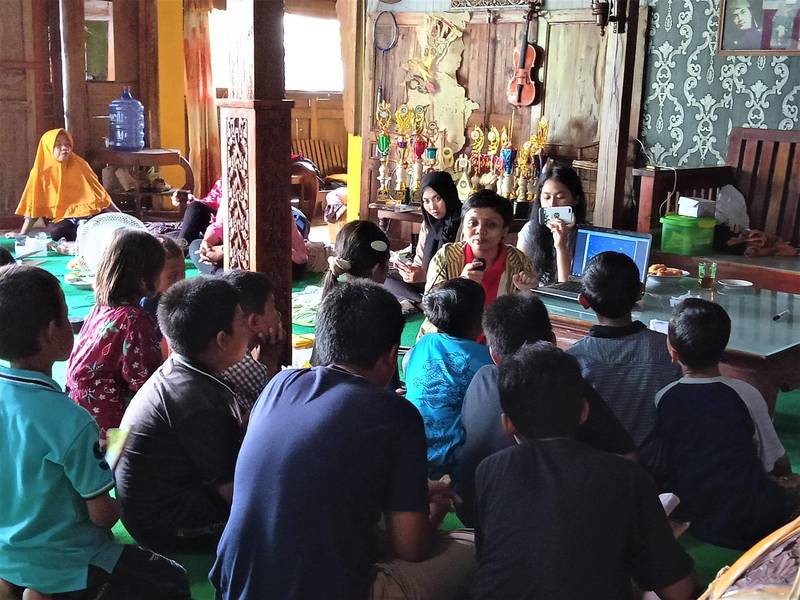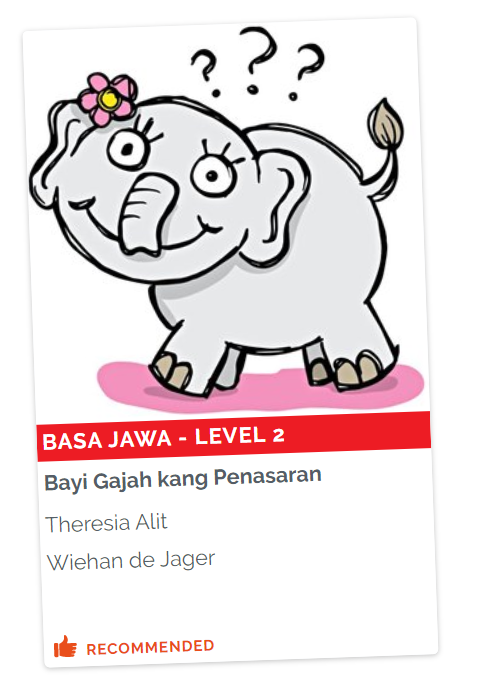StoryWeaver's partnership with Jala
Posted by Remya Padmadas on October 21, 2019Jala is a translation platform that combines human skill with translation technology to make high quality translations accessible to those who need it the most. It collaborates with organisations, communities and individuals to help bridge the language barriers and increase access.
Earlier this year, Jala teamed up with StoryWeaver to help build a high quality repository of openly licensed storybooks in Chinese and Bahasa Indonesia. To get some insight into the translation process, they interviewed Sophia, a Jala user and hobbyist/ freelance translator, who translated five stories on StoryWeaver from English into Bahasa Indonesia. You can read an excerpt from the interview below.
Sophia, who translated storybooks from English to Bahasa Indonesia.
Hi Sophia! Thanks for being such an active user on Jala! Can you tell us a little about why you decided to translate the StoryWeaver books?
Hello! It was my pleasure. Well, firstly a little background about me. Bahasa Indonesia is my native language, but I moved to Singapore at the age of 15, and then later moved to the UK. So English has been the language I have spoken more actively. But ever since I started working in the publishing industry and have focussed on developing Singaporean content for Singapore, I began to miss home, and I began thinking about reconnecting with Indonesia. I feel a little like an outsider to Indonesia now, and I was not sure how I could help local readers in Indonesia. So when the opportunity to translate children’s books on Jala into Bahasa Indonesia came along, I was quite excited by the idea! It felt quite perfect. While my Indonesian language abilities have withered a little, mainly due to lack of practice, I felt that working on translation really helped to revive my language skills! Translating children’s stories had its own challenges for me. For example, word choice, which had to be suitable. I had to be sensitive about how an Indonesian child would understand the words I had chosen. It made for an interesting puzzle for me!
That’s great. What did you like most about the stories that you translated?
Like any children’s book, there was a nice rhythm to the stories. There were moments when I felt that the words in English had a rhythm, which I tried to capture in my translation. Knowing the natural rhythm of the book, I tried to ensure my translation stayed true to the original in terms of sentence length and word choice.
I liked that the stories were upbeat and (mostly) positive. For example, in Fati and the Honey Tree, even though the girl (Fati) fell down and hurt herself, there was still a positive message at the end. I also enjoyed the unique settings for the stories, everything from the environment to the characters and how they interacted with their surroundings.
Fati and The Honey Tree
The Indian and Ghanian cultures were very refreshing to me, and something I feel that is lacking in publishing, as most settings are very Western-centric. Finally, I liked how each story teaches something. For Let’s Play, it was science, through the introduction of simple concepts in a child’s everyday world.
This is really great to hear! What was the translation process like for you?
I was very methodical in my translation process, after the first one, I actually figured out what worked best for me and then came up with my own methodology which I actually have written down on my phone!
To start off I usually skim the original text first. I then proceed to do the translation line by line on Jala. I go through it once and have a first draft ready. I then go through both the original and the translation, by carefully comparing the two, and making any corrections along the way. I then read through just the translation to see how it flows and if I’m comfortable with it on its own. When I’m happy with what I have, I leave it for a day and then come back and read the translation again and do a final comparison with the original before submitting the piece. I like how Jala will always save my work, and I know that my progress will be safe until the next time I revisit the project!
Stories on the Jala platform
Of all the translations that you worked on, which was your favourite story to translate, and why?
I liked Fati and the Soup Pot the best.
Fati and The Soup Pot
Fati’s attitude was really funny in the story. I also liked how despite the fact that Fati’s mother knew that Fati had done wrong, she did not punish or scold Fati in the way you would expect parents to. In addition, I felt that the description of the cooking process and the listing of ingredients was a nice touch! If you are curious enough, you could attempt to recreate the dish! It also really liked that the child was involved in the cooking process!
What do you enjoy about freelance translation?
I think what I find most appealing is the extra income. But I also do believe there is a more interesting aspect to freelance translation. For instance, gaps in languages can be filled by multilingual individuals or translators. Being able to help and contribute to a specific skill is really interesting! I also think it’s a really great cycle, the more you do, the more interested you are, and the more that you learn! For example, when there are natural disasters, you see NGOs making open (and urgent) calls for translators for a specific language. Often, contributions can be through knowledge instead of money or goods, which is so meaningful when you are filling a gap. Even in non-dire circumstances, I believe that translators can make a difference.
To read the original interview, click here.
You can read the stories translated by the Jala Community on StoryWeaver here.
Please join the conversation by leaving your thoughts in the comments section below. You can also reach out to us through our social media channels: Facebook, Twitter and Instagram.
Be the first to comment.#FreedomtoRead2020: Theresia Alit on creating a digital library of 50 storybooks in Basa Jawa
Posted by Remya Padmadas on March 11, 2020
Theresia Alit is a freelance translator, who translates books from English-Javanese to Bahasa Indonesia-Javanese and vice versa. She is passionate about creating a repository of storybooks in her mother tongue, Basa Jawa, as she feels that the number of people who tell children's stories in Basa Jawa is decreasing. Previously, she has worked on translating stories into Javanese for a project called Serat Kancil. As part of the Freedom To Read 2020 campaign, she has created a digital library of 50 storybooks in Basa Jawa.
In this email interview, Theresia writes about translating books into her mother tongue and the importance of creating children's books in the Basa Jawa.
Do tell us about yourself, your interests, your work.
My name is Theresia Alit, and I am from Indonesia. I am a freelance translator, and I work on translations from English-Javanese to Bahasa Indonesia-Javanese and vice versa. Speaking of interests, I am very interested in traditional culture, languages and people.
We would love to learn about your personal relationship with Basa Jawa - do tell us about it.
I am a native speaker of Basa Jawa, and was raised speaking the language. I find it sad that a lot of people in the younger generation of today do not really speak or understand Basa Jawa, despite it being their mother tongue.
How did you come across StoryWeaver and the Freedom to Read campaign?
I came to know about StoryWeaver and your Freedom to Read campaign on Twitter, from a retweet by the Wikitongues account.
Why do you think is it important to have children’s books in Basa Jawa?
I feel that it is extremely important for the younger generation to learn and read Basa Jawa. In fact, yesterday, I did a campaign with a community of small children, and they were really enthusiastic about reading stories in the language!

Theresia Alit conducts reading sessions for children in Basa Jawa in Indonesia
Of the 50 storybooks that you translated, which story would be your favourite and why?
I really enjoyed the book, Bayi gajah kang penasaran. It's so funny!

What are some of your favourite books from childhood? Is there any memorable reading moment that you would like to share?
Some of my favourite books are The Little Prince, Asterix and Obelix, Uthak-uthak Ugel (folktale), etc. When I read a book, I feel that I am moving into another world altogether. (just like Puchku!)
You can read all of Theresia Alit's translated storybooks here.
Do join the conversation by leaving your thoughts in the comments section below. You can also reach out to us through our social media channels: Facebook, Twitter and Instagram.
comment (1)Selected Partners for StoryWeaver Freedom to Read 2020
Posted by Remya Padmadas on February 21, 2020
At StoryWeaver, we believe that every child deserves to have joyful reading material in her mother tongue. To make this a reality, we have been building all-digital libraries in underserved languages through the 'Freedom to Read' campaign.
In November 2019, we opened applications for the 4th edition of Freedom to Read, inviting organisations and individuals to partner with us to achieve our goal: the co-creation of digital libraries in languages with few or no storybooks by February 21, 2020 - International Mother Language Day. Each of these free-to-use digital libraries will contain at least 50 quality-assured books - creating more storybooks, in more languages, that serve more children all over the world.
We are overwhelmed by the response to Freedom to Read 2020. A BIG thank you to the applicants - we are inspired by your work in the field of literacy and language.
Based on our guidelines, relevance of work, and a rigorous evaluation, we have selected 5 organisations and 18 individual Language Champions to collaborate with us to build and share digital libraries in 20 languages.
Here is the list of partners for Freedom to Read 2020:
Partner Organisations
| Target Language | Organisation |
| Amharic | Ras Abebe Aregay Library |
| Bodo, Nepali and Karbi | Pragyam Foundation |
| English-Surjapuri | Azad India Foundation |
| Fijian | Fijian Language Society |
| Hindi-Magahi | Karunodaya Foundation |
Language Champions
| Target Language | Language Champion |
| Amharic | Kaleab Getachew |
| Arabic | Amina Bouiali |
| Chhattisgarhi | Rohit Sharma, Er. Vivek Rathore, Charan Das Mahant |
| Farsi | Marzieh Nezakat |
| Basa Jawa (Javanese) | Theresia Alit, Sigit Apriyanto |
| Kochila Tharu | Sanjib Chaudhary |
| Lepcha | Minket Lepcha |
| Persian | Nazanin Karimimakhsous |
| Rana Tharu | Kamal Singh Rana |
| Setswana | Leelo |
| Sambal | Leo Fordan |
| Sambalpuri | Dron Sahu |
| Sindhi | Bhawana Dhameja P, Bharti Menghani |
| Tu'un savi | Francisco Amado Cruz Ramírez |
We shall be getting in touch with the selected partners to discuss the next steps.
We are so grateful to everyone who applied - thank you once again for your participation, interest and support! We shall do our best to reach out to you to explore alternate ways to collaborate.
Do join the conversation by leaving your thoughts in the comments section below. You can also reach out to us through our social media channels: Facebook, Twitter and Instagram.
Be the first to comment.